W H Bulloch E B Meyrowitz Antique Brass Histological Microscope Sn-111 C-1891

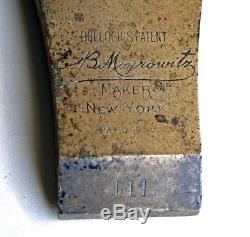
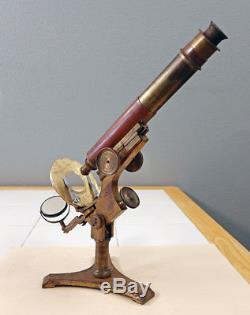
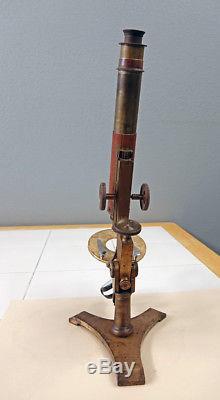
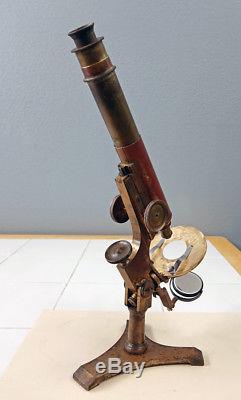

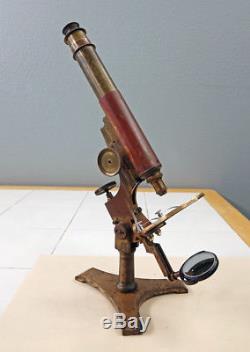
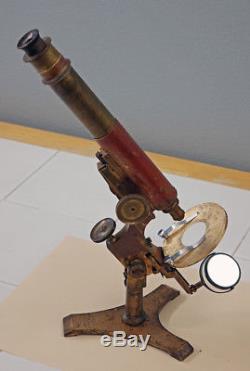
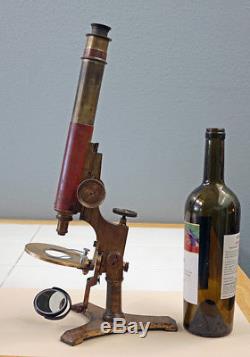
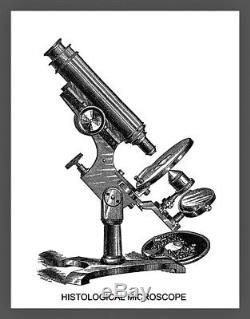
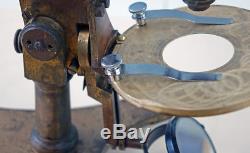


W H BULLOCH E B MEYROWITZ ANTIQUE BRASS HISTOLOGICAL MICROSCOPE SN-111 C-1891. BULLOCH E B MEYROWITZ ANTIQUE BRASS HISTOLOGICAL MICROSCOPE SN-111 CIRCA 1891. Bulloch of Chicago, Illinois that dates from the latter part of the 19th Century. This instrument comes from the period shortly after Bullochs death when his longtime agents in New York, E.
Meyrowitz, acquired Bullochs entire physical plant and continued production of his instruments for a time before the close of the 19th Century. NOTE: For more information on W. Bulloch and his relationship with the E. This instrument is signed on the top rear of the tripod foot as follows (see close-up image that shows this inscription): BULLOCHS PATENT, E.
Meyrowitz , MAKER, NEW YORK, PATD 1880. Also included is a serial number stamped on the rear of the same tripod foot, 111.This serial number does not track with all the former serial numbers issued by Bulloch himself and evidently represents a new series established by E. Meyrowitz as their successor to Bulloch in the continued manufacture of his instruments. This serial number dates this instrument to circa 1891. Note: The 1880 Patent date is actually incorrect, as the Patent referred to was actually dated 1879. Bulloch was awarded US Patent No.
215,878 on May 27, 1879 for three (3) improvements to the microscope, namely. A more efficient means for using the mirror and substage with its accompanying accessories (Bullochs saddle fitting for improving the steadiness and freedom of motion of the swinging substage mirror assembly).
A more efficient method of perfecting the fine adjustments (Bullochs long lever fine focus system); and. A method of adjusting the stage to the optical axis (Bullochs push and draw system for centering a revolving stage to the optical axis).
These patented features were incorporated into several of his instruments including the Histological stand, which in this case features patented improvements 1 and 2. We will include a copy of Bullochs Patent with this microscope. The Patent features two pages of detailed diagrams that highlight these features that will be of interest to Bulloch microscope collectors. Accompanying this listing is a catalog cut of Bullochs Histological stand extracted from his 1890 Illustrated Price List of Optical Instruments, Microscopes And Microscopic Accessories (see image). The catalogue cut illustrates the fact that this model was available with either a fixed circular stage with slide clips, as is the case with the featured instrument, or a rotating circular stage with a sliding slide carrier.
It also shows a single rotating tailpiece that can carry both a mirror and condenser in moveable fittings. In the case of the featured instrument, only the moveable mirror is included. This microscope is built upon a brass tripod base. Rising from the center of the base is a cylindrical brass pillar that rises to a compass joint that supports the limb and, in turn, the rest of instrument.
The compass joint allows the instrument to incline to any angle from the vertical for the comfortable viewing of slide preparations mounted atop the stage. Small circular brass stops attached to the side of the limb prevent the limb from being over-inclined beyond either the horizontal or the vertical orientation. In concert with the 1879 Bulloch Patent, the leading edge of the limb of this microscope is notched at the compass joint to allow for a space between the limb and the stage support. Instead of the stage being attached directly to the leading edge of the compass joint as in many other microscopes, the stage on this instrument is mechanically attached to an upper portion of the limb above the notch by an L-shaped bracket or saddle so as not to interfere with the space between the compass joint and the rear of the stage support bracket. The reason for this will become evident as you read on.This instrument is equipped with a 98mm diameter circular stage with a wide 38mm diameter central aperture. A pair of slide clips is found atop the stage.
There is also evidence of some fancy scroll work atop the stage. Filling the space between the leading edge of the compass joint and the rear of the stage support bracket is a rotating mirror support bar. The pivot point for this mirror bar is the center of the leading edge of the compass joint so it can rotate around the axis of the stage both below (to provide oblique illumination) and even above the stage to provide incident light to illuminate opaque objects atop the stage (please see the accompanying composite image that shows the versatility of this arrangement).This appears to be Bullochs version of the swinging substage mirror assembly that was first invented and Patented by Joseph Zentmayer in the year 1876. The sides of the mirror bar form a male dovetail supporting a smaller female dovetail piece that fits into the bar and that slides along the bar and supports a yoke-mounted 50mm diameter plano-concave mirror. The mirror can be moved either closer to or away from the stage along the mirror bar. Coarse focus is by rack and pinion controlled by a pair of oversized brass milled heads. The rackwork on this instrument is horizontal rather than angled (see image).
Fine focus is by micrometer screw acting on a through-the-limb long lever device that is featured in Bullochs 1879 Patent. Fine focus is controlled by a brass milled head mounted atop the limb. The track along the face of the limb that supports the body tube and its associated rackwork is split in two areas forming a moveable middle segment, which allows for the movement of the body tube by the fine focus mechanism.
The body tube of this microscope includes a long drawtube. At the top of the drawtube is a top-hat style ocular (unmarked). At the base of the body tube is a single B&L ½ -inch objective.
NOTE: Bulloch did not manufacture his own objective lenses. Thus, both he and his representatives including the Meyrowitz Brothers customarily supplied objectives with the microscope made by others including Wales, Tolles, B&L or Gundlach. When this instrument is set up for observations with the drawtube fully extended, it stands about 17.5 inches tall making for a relatively large and impressive antique brass microscope (see accompanying image comparing the height of this instrument to a standard bottle of wine). When the draw tube is fully nested into the body tube, the instrument stands about 13.5 inches tall in its collapsed state. The microscope weighs 6 pounds.There is no wood case or any other accessories that accompany this microscope. NOTE: The accompanying images that were captured under ambient light conditions are a part of this statement of condition.
Please take the time to view each of the images so you can confirm the condition of the instrument and so you will know in advance what you will be getting should you prove to be the proud new owner of this fine and quite rare American made microscope. In summary, this Bulloch microscope is in relatively fair to good cosmetic, optical and mechanical condition considering its age.
This instrument came to us in very poor cosmetic condition. It was covered with a very thick layer of dust and oily grime that took some time to remove using dilute Windex. We debated whether or not to completely strip the brass of age related tarnish, but decided not take any other actions leaving any possible further restoration to a future owner should he decide to do so. The instrument has a very nice honey gold age patina, but has little in the way of original lacquer still present. There is a considerable amount of surficial tarnish present as evidenced by the accompanying images. We completed our limited restoration by giving the brass parts a coating of Renaissance Wax from the GEMMARY to protect it. Relative to the optics, the B&L objective lens is in very good optical condition with no internal defects present. However, the top hat eyepiece is missing its lower screw-in optical element and so prepared slides viewed with the instrument will not come to focus. As this instrument is most likely to be placed into a collection and not used on a regular basis for microscopy, this defect in the eyepiece should not be a major concern to the seasoned collector of Bulloch microscopes. The plano concave mirror is in excellent condition.However, it is not original to the microscope, but is a more modern replacement. The mechanics associated with this instrument are in relatively good condition. The coarse focus works through most of the range, but there are a couple of rough spots.
The fine focus mechanism works smoothly and perfectly a nice testament to Bullochs patented long lever focus system design. The swinging substage mirror system works smoothly as designed.The slide clips atop the stage are not original but are more modern replacements. In summary, this instrument is a nicely preserved example of a Bulloch Histological Microscope certain to command a prominent place in any antique microscope collection.
Rescued from a thick coat of dust and grime and potential oblivion, it nicely illustrates several of Bullochs brilliant design features codified in his 1879 US Patent. A word of advice to potential buyers: All W.Bulloch instruments are very rare birds that rarely rise from the dust of the past, so you will need to act quickly to make it your own! BULLOCH, MICROSCOPE MAKER OF CHICAGO & HIS RELATIONSHIP WITH E. Bulloch (1835 1891) was born in 1835 in Glasgow, Scotland where he lived until age 17.
About 1852, he and his family immigrated to New York City in the United States. Here young Walter learned the trade of a tailor from his father. However, his innate fondness for mechanical pursuits made him dissatisfied with his future prospects as a tailor. He soon became apprenticed to Messrs. Pike & Sons, then a leading firm of opticians and scientific instrument makers located on Broadway in New York City.
After serving for a time as an apprentice, he decided to open his own optical-mechanical workshop in the City. But, not long after this, the US Civil War broke out and Bulloch decided to enlist as a private in the 12th New York Volunteers on the Union side of the conflict. Back in New York City he formed a business partnership with William Wales, a well-known maker of objective lenses. He continued in business with Wales until the year 1866, when Bulloch moved to Chicago, Illinois. In Chicago, Bulloch proved to be very successful and had accumulated considerable means over the period of 1866 to 1871. This proved to be his most productive period when it came to microscope production. Then, on October 8 & 9, 1871, a disastrous fire completely consumed his workshop and tools as well as some microscopes that he had under construction at the time. As a result of this misfortune, Bulloch suffered a significant financial and psychological loss from which he never fully recovered. In an attempt to rise from his misfortunes, he moved to Boston and was for a time associated with another famous American optician, R. However, in 1889, still suffering financially, he accepted a position with the Bureau of Weights and Measures in the U. Coast and Geodetic Survey in Washington, D. But, he soon chafed under the bureaucratic restraints associated with working for a US government agency. Even though he continued to suffer from poor health his perseverance led him to struggle on with his microscope business. He opened a new place of business at No. 303 Dearborn Street, a very advantageous business address, and began to work again. However, it was not for long. After struggling with ill health for about six months, he was forced to stop work. Bulloch died on November 5, 1891 at Elgin, Illinois where he had gone for treatment. Bulloch, including all patents, models, drawings, etc. They continued to manufacture his microscopes under the Bulloch name for a time. They used residual parts left by Bulloch to assemble the instruments and started a new set of serial numbers unrelated to the numbers used by Bulloch. The firm likely ceased manufacturing operations completely before the year 1900, producing relatively few instruments in total. He was also credited with producing the first American made petrographic polarizing microscope in the form of his Lithological Stand in the year 1880.Due in part to combinations of misfortunes and ill health, Bulloch produced less than perhaps 750 microscopes over his lifetime. Note: As of 2014, serial numbers 52 to 675 are documented by the antique microscope collection community.
But each of his instruments reflects his rapt attention to detail and his ardent desire to achieve a high level of perfection in terms of optical and mechanical performance. He constantly experimented with new enhancements and made continual improvements to his instruments over time. As a result, his surviving microscopes, which rarely surface, are in extremely high demand by collectors. THE MONTANA LOGGER is very pleased to offer this W.
We will also entertain reasonable offers for this very rare instrument. FREE scheduling, supersized images and templates. Make your listings stand out with FREE Vendio custom templates! Over 100,000,000 served.
Get FREE counters from Vendio today! The item "W H BULLOCH E B MEYROWITZ ANTIQUE BRASS HISTOLOGICAL MICROSCOPE SN-111 C-1891" is in sale since Wednesday, September 26, 2018.
This item is in the category "Collectibles\Science & Medicine (1930-Now)\Scientific Instruments\Microscopes, Lab Equipment". The seller is "mtloggera" and is located in Hamilton, Montana. This item can be shipped worldwide.- Antique Brass Microscope: Histological Microscope
- Country of Manufacture: United States of America
- Manufacturer: W. Meyrowitz
- Product Type: Microscopes, Lab Equipment

